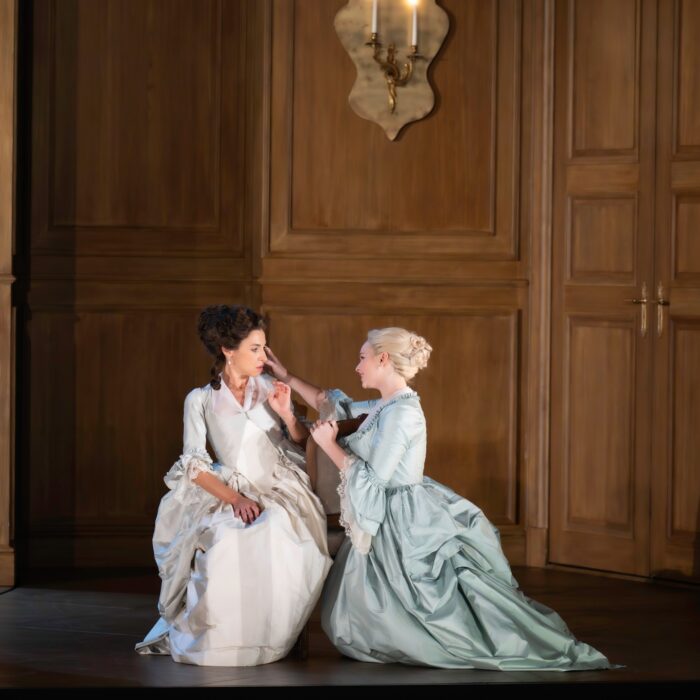
The Ring in San Francisco: ‘Rhine-Dining’ & ‘What’s Opera, Doc’
By Lois Silverstein(Credit: Stacey Bode)
San Francisco Opera is in the midst of its month-long festival dedicated to Wagner’s “Ring Cycle.” In the coming weeks, Lois Silverstein will explore her experience not only revisiting the 2018 opera production but several of the events and panels presented by the company.
San Francisco Opera’s (SFO) recently concluded “Virtual Ring Festival” continues to delight, even if the curtain has fallen. It remains as dynamic as ever in the conversations that constituted the unique production, made available as part of SFO’s streaming service. The digital program has been providing a variety of entertaining conversations this past month inspired by the Wagnerian classic.
Fred Plotkin, renowned music lecturer and writer, and mezzo-soprano Jamie Barton, recently came together to talk “Rhine-Dining”—a gastronomic and entertaining exploration of the world of the Nibelung Trilogy—in an inimitable fashion. Plotkin spun a menu of Rings and Dings, Rheingold Beer and Frog Jam, which corresponded to moments and characters from the “Ring Saga,” including Valkyries and Rhine Maidens, Giants, and Freia’s Golden Apples. All the while Barton, who has played the goddess Fricka in stagings of the “Ring Saga,” added tidbits and insights from her own experiences backstage during and after production, highlighting especially the demands put upon a ‘goddess’ performer in the way of food.
The two played off each other marvelously as Plotkin exhibited his inventiveness in coming up with foods that would celebrate “Ring moments” while nourishing those who were engaged in the oft-daunting task of “Ring Saga” watching, let alone the challenge faced by those performing the legendary Wagnerian roles. These creative gourmet accompaniments include: “Rings,” which of course constitute Ho Hos, mini-glazed doughnuts, cannelloni pasta, onion rings and bagels; “Frickadellen”—emphasis on the “Fricka”—which are the famous Germanic meat patties; “Rainbow Chard,” as a light salad honoring the legendary Rainbow Bridge; “Erda Apfels,” which translates literally to the “apples of the Earth Goddess Erda” and would, in the unromantic modern kitchen, look very much like potatoes; “Mead”—a staple of the Norse diet—substituted by watermelon-flavored Nixle Water and Rheingold Beer, the significance of the latter’s name being self-explanatory; “Niebelheim,” the land of the dwarves, providing the assorted snacks, the bite-sized meals reflecting their mythical bite-sized stature; “Dragons,” a crucial part of the Saga, represented as Dragonfruit (Pitaya) of two sizes and colors; “Ropa Vieja,” Spanish for “web of destiny,” is a Cuban dish which will honor the Norns who spin the fate of mankind; and, to round out the meal, “Hägen Dass,” a delicious take on the ever-present theme of ice and snow through the opera.
Sounds like a fun take on dining and opera? We should say so!
✺
Should you like animation, Craig Kausen, director of the Chuck Jones Animation Center; Pete Doctor, chief of Pixar Animation; and voice actor John Morris, who the world knows as “Andy” from Pixar’s award-winning Toy Story franchise, took top billing alongside Wagner himself in a discussion of “What’s Opera, Doc?,” the famous 1957 Looney Tunes cartoon that is on perpetual display in the Smithsonian Museum. The conversation was sponsored by the BRAVO! Club of the SFO.
The conversation opened with the seven-minute-long cartoon itself. Elmer Fudd and Bugs Bunny carry on themes from the “Ring Saga” with panache, the voice acting done by the incomparable Mel Blanc. Craig Kausen is the grandson of Chuck Jones, pioneer American cartoonist, and animator, and has inherited the love for and delight in the development of the Looney Tunes and Merrie Melodies art forms championed by his grandfather. Pete Doctor talked in detail about how Wagner fans could poke fun at the imposing music and treat it in a less serious way as a means to engage with a broader audience. The two animators, accompanied by Morris, spoke with enthusiasm and great energy about how opera was the “straight man” of comedy, the innate foil of humor, as music can bypass academic seriousness. Music in cartoons drives action and although it is not a realistic medium, music makes it believable. Music, they said, is the key to the success of cartooning.
They discussed a range of techniques that turn highly-developed technical skills into artistic works which satisfy creators, animators, and audiences alike. The insight which the three artists provided and their energy and imagination gives us a hint as to the incredible talent required to transform an idea into an animation. Craig Kausen said the greatest impact his grandfather’s legacy had on him was making him realize that, for an artist, to believe in one’s unique creative genius is the most important skill of them all.
After watching Plotkin and Barton, as well as Kausen, Doctor and Morris, discuss the kaleidoscopic aspects of what goes on behind and between the scenes of an opera, one is left realizing that opera is so much more than what we see on the stage, and creativity flows through and benefits everything that opera touches.
Categories
Special Features

